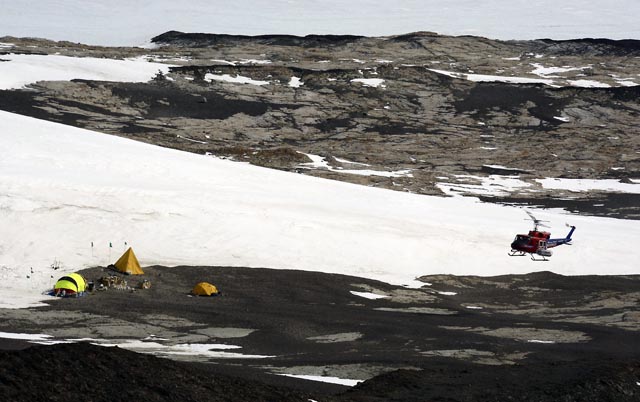Page 2/2 - Posted February 12, 2015
Volcanism played major role in reshaping paleo landscapeIt was a different and hotter world a couple of hundred million years ago. The supercontinent of Gondwana was beginning to break away from Pangea, a C-shaped landmass once composed of all the Earth’s continents. Antarctica was shifting locations, but still far enough south that much of the Paleozoic and Mesozoic floras would have endured months of light and months of darkness at a single stretch of time. “We don’t have anywhere in the world [today] where plants grow in extended light and extended darkness,” noted Rudolph Serbet, collection manager of paleobotany and paleobotanist at the University of Kansas Biodiversity Institute and co-leader of the Allan Hills expedition with Gulbranson. It was also a highly volcanic world, as the continents sheared apart at the beginning of the Jurassic period that followed the Triassic. Allan Hills was likely part of a large volcanic system that at some point around 180 million years ago catastrophically collapsed on itself, according to Gulbranson. A sort of fish-shaped feature, with a gaping mouth, called Carapace Nunatak had been the site of an ancient lake. Lava from volcanic vents at nearby Coombs Hills flowed into the lake, creating what are called pillow basalts. Plant material within sediments would have been swept up into this cataclysmic flood, and subsequently preserved in chert lenses. This type of preservation is called permineralization where open spaces within plant tissues are filled with minerals, in this case silica, and the remaining organic materials remain intact. Permineralized fossils allow scientists to look at the cellular details of tissue systems within plants in extraordinary detail. “The fossil plants are three-dimensional, so you can see the morphology and internal structure, which makes it really nice. You can look at the plant in more detail,” Serbet explained. The chunks of Jurassic rocks are relatively easy to collect. After being eroded out of volcanic rock walls of the nunatak, or rock outcrops above the ice, they are carried by glacial flow to form moraines, which are essentially piles of rock and soil debris. The fossils from Carapace Nunatak look almost like rough chunks of marble at this point and are easily distinguished from the dark brown volcanic rocks. Eventually, the rock will be cut apart like a loaf of bread using a saw with diamond-tipped blades. The specimen is then etched with hydrofluoric acid and the surface treated with acetone, the main ingredient in nail polish remover and paint thinner. A piece of plastic, cellulose acetate, is then rolled over the sample, allowed to dry, and then pulled away to reveal a thin section of the plant in the rock that can be examined under a microscope. That’s when the real work begins. “Our job is to reconstruct the plants, which is quite hard,” Serbet explained. “ It’s like a salad or a compost heap, and we have to use different characteristics of the plant to put the right plant parts together – a little bit of detective work.” Southern Hemisphere fossils provide mirror for present-day plant migrationThere are no forests in Antarctica today. Over a several-hundred-million-year expanse of time, the greenhouse world that allowed flora to occur at such high latitudes turned into an icehouse, as the southern continents that formed Gondwana went their separate ways. Ocean currents changed with continental drift – carbon dioxide levels in the atmosphere also dropped – and Antarctica’s ice sheets began to form more about 34 million years ago. The rich record of fossils, spanning millions of years, tells a story of plant evolution and migration that could one day be repeated. Climate change in the northern hemisphere is already pushing some species to higher latitudes and altitudes as conditions warm. What will survive and thrive – and what will go extinct? “The importance of these fossils in Antarctica is that they preserve [a previous] record of plant community change and plant migration,” Gulbranson said. “If we’re interested in how forests are going to develop – how plants live – in environments that have four months of continuous light and four months of continuous darkness, we can look at the fossil record to get a better understanding of those types of environments.” The team collected more than 2,500 kilograms of rocks during their expedition to Allan Hills and Carapace Nunatak. Most of the fossils came from the Jurassic and Triassic, with a few dating as far back as the Permian, representing nearly 100 million years of geologic history. “It will move our science forward by leaps and bounds with all of those Triassic and Jurassic collections,” Gulbranson said. Added Serbet, “It’s really neat the stories we’ll be able to tell that’s going to come out of this material.” NSF-funded research in this article: Edith Taylor and Tom Taylor, University of Kansas, Award No. 1142495 |
"News about the USAP, the Ice, and the People"



For USAP Participants |
For The Public |
For Researchers and EducatorsContact UsU.S. National Science FoundationOffice of Polar Programs Geosciences Directorate 2415 Eisenhower Avenue, Suite W7100 Alexandria, VA 22314 Sign up for the NSF Office of Polar Programs newsletter and events. Feedback Form |




